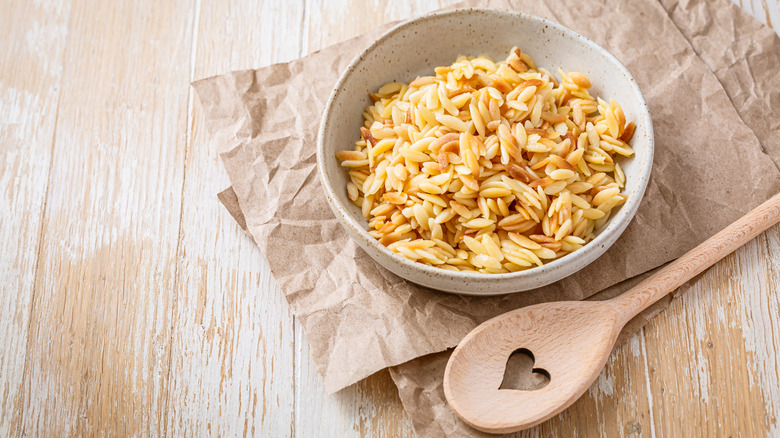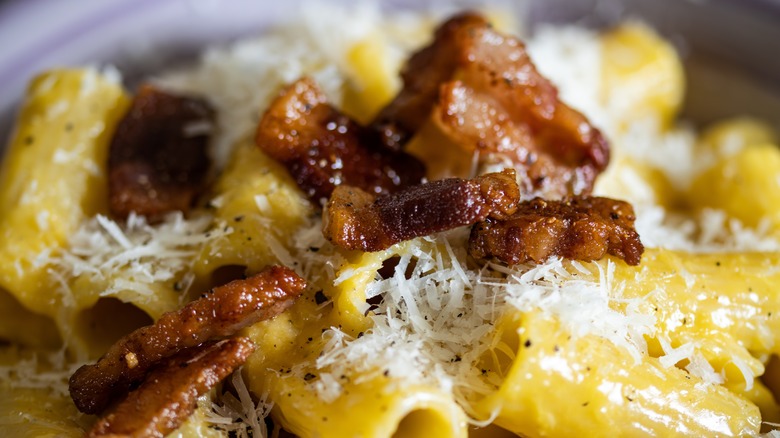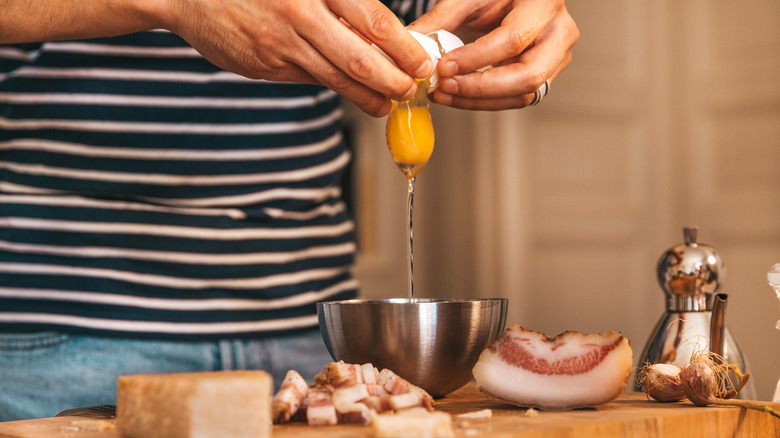Swap Spaghetti With Orzo For Carbonara And Witness Greatness
Super simple spaghetti carbonara still manages to be divisive. Any version is bound to elicit comments from purists and experimenters alike (like the way some cooks are adamant that you must use guanciale and no cream or garlic, ever). But really, it's one of the most flexible recipes you can have in your arsenal. Many people usually have some kind of pasta and cured pork on hand, as well as eggs and cheese. Frankly, any combination of these ingredients is going to produce something delicious and filling — and isn't that the point? You can make pasta swaps for whatever you have on hand, but if you're looking for something quick, easy, and comforting, try switching the spaghetti in your carbonara for orzo.
A small pasta shaped like rice, orzo cooks quickly, and a little goes a long way; the little grains are perfect for taking on big, bold flavors. The end result is a risotto-like dish with the taste of a silky smooth carbonara — it's something you'll want to grab a spoon for.
Orzo makes for an ultra creamy twist on a Roman classic
For an ultra-creamy carbonara experience, you'll want to treat the orzo like you're making risotto. Even though it's pasta, which you would normally cook in salted water and drain, orzo can be treated similarly to arborio rice, but with far less stirring. You can pour all the liquid into the pan and simmer, stirring only occasionally to make sure it's not sticking. The orzo will slowly absorb the liquid until you're left with plump, tender pasta that's a perfect recipient for the makings of carbonara.
Choose a flavorful liquid to cook your orzo in, like broth or a combination of half broth and half wine. If you don't have broth or wine, use regular salted water. Be judicious with the salt, though, because the cheese, guanciale, pancetta, and bacon are all plenty salty, and you don't want an over-salted final dish.
Since this riff relies on a risotto-like approach, feel free to sauté minced shallot or garlic in the rendered guanciale fat to kick things off, which you can then deglaze with a bit of wine after adding your orzo and toasting it. If you're worried about the carbonara police, skip sharing any evidence to social media and just enjoy the dish for what it is — quintessential comfort food.
Don't fear scrambling your eggs, temper them instead
The trickiest part of a carbonara, and the reason many home cooks simply abandon making the dish altogether, is accidentally scrambling the eggs — a mistake that can ruin your carbonara. There's finesse involved in making it, and most often, the culprit is too-high heat — either the pan is too hot, or you've left the burner on. However, with a few tweaks, you can get the sauce silky smooth.
Tempering, in particular, is essential to a seamless carbonara. This method gradually heats the eggs (usually by introducing hot ingredients incrementally) so they don't overcook. You can temper your eggs by either splashing in some pasta water or stirring in a bit of the cooked orzo. Either way, removing your pan from the heat is important — you'll want to at least turn the burner off, and ideally move your pan to a cooler area of the stovetop before adding the tempered egg and cheese mixture to your orzo. Just remember, no matter how you choose to approach it, stirring and tossing consistently until the orzo is completely coated is the key to achieving glossy sauce heaven.


